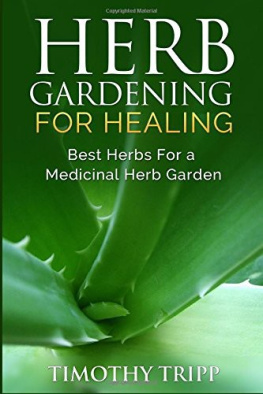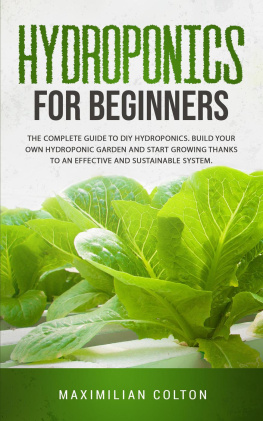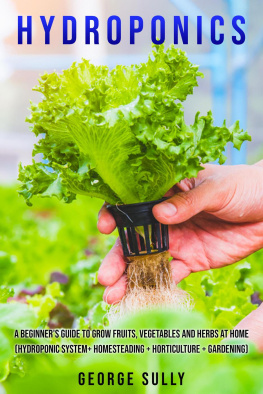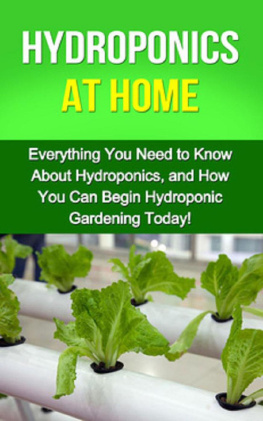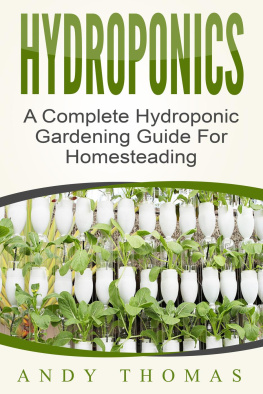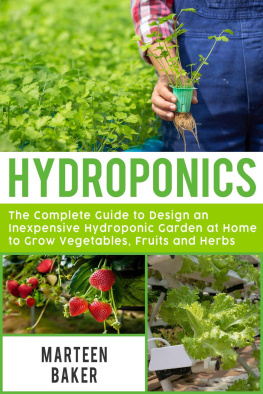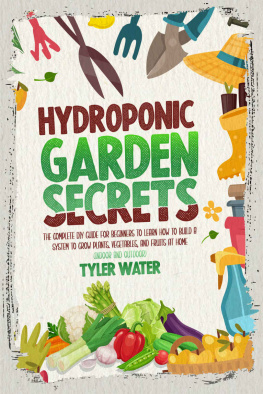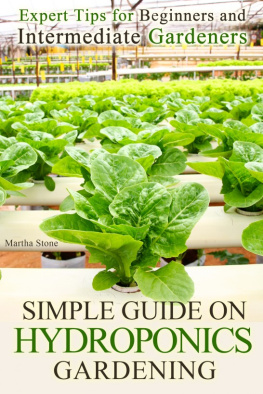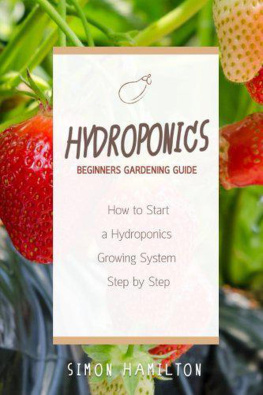Hydroponics:
Hydroponic Gardening Basics
By
Timothy Tripp
Table of Contents
Hydroponics: Hydroponic Gardening Basics
By Timothy Tripp
Copyright 201 3 Timothy Tripp
Reproduction or translation of any part of this work beyond that permitted by section 107 or 108 of the 1976 United States Copyright Act without permission of the copyright owner is unlawful. Requests for permission or further information should be addressed to the author.
This publication is designed to provide accurate and authoritative information in regard to the subject matter covered. This work is sold with the understanding that the publisher is not engaged in rendering legal, accounting, or other professional services. If legal advice or other expert assistance is required, the services of a competent professional person should be sought.
First Published, 2013
Printed in the United States of America
Introduction
Hydroponics (Latin for working water) is the practice of growing flowers or edible plants using water instead of soil. When people think of hydroponics they usually envision huge greenhouse-type commercial enterprises with lab-coated scientists wandering about making adjustments. But hydroponics is actually very simple and a growing number of people are gardening and farming in their homes using hydroponics. Some of these farmers turned their hobby of hydroponic farming into profitable enterprises.
There are very good reasons for turning to hydroponics rather than more traditional growing methods. The plants generally grow faster and bigger than plants grown in soil. Hydroponics can also be a good way to grow plants in places where the soil is not sufficient to support crops or in places where the outside environment is hostile to the plants you want to grow. The extreme heat and arid climate of the desert or the harsh winters in Alaska are two examples of where people might want to establish a hydroponic garden.
Chapter 1. What Equipment is Needed?
A hydroponic gardening system is probably not something you want to build yourself when youre first starting out. Pre-built set ups are better for beginners. Until you have done it and made some mistakes, a pre-built system will minimize losses; you can study the system and understand how it works so that if you ever do want to build a system yourself youll know how. Pre-built hydroponic systems range from a simple bucket system to a miniature greenhouse. They come with grow lights, sphagnum moss, pumps and airstones, some nutrients, and the growing medium.
If you buy a basic, simple system to grow one to a dozen plants will cost as little as $35 or as much as several hundred dollars.
If you do decide to build your own rather than learn with a pre-built system, remember that your pots and containers will need solid support. Each gallon of water weighs about 8 pounds so a hydroponic system can be quite heavy. If your system is in your house, keep in mind that the floor is the coolest place in the room and thus the water will be cooler. This could adversely affect tropical plants or those that need a warmer natural growing climate. You will also need pumps and airstones to aerate the tank.
A hydroponic growing system needs a nutrient tank, a base for the plants, pumps, airstones, plastic hosing, nutrients, water, and grow lights.
Chapter 2. What Type of Growing Room Do You Want?
Very few people have the resources to buy a special greenhouse for their hydroponic farm. You can actually use any room in your home as long as you have adequate grow lights. Your hydroponics farm can be in your basement, in a spare room, or in a den or an office. Some people even use a part of their living room for their farm.
One of the most important considerations is ventilation. Plants take in carbon dioxide and give off oxygen; thats how our atmosphere can support all the life that depends on it. By allowing enough ventilation in the grow room youll have a healthier home and a healthy crop.
Most plants also need humidity. Part of the photosynthesis process involves transpiring or giving off moisture. Plants can become dehydrated if there is not enough relative humidity but once it exceeds 85% they can suffer stress. There are inexpensive gauges you can get to measure relative humidity and keep it healthy for your farm.
Chapter 3. Types of Hydroponics Systems
There are several types of hydroponics systems that you can use. The one you choose depends on how much space you have and how big you want your garden to be.
A water culture system is very simple, consisting of something to hold the plants, a pump and airstones, and a receptacle for the nutrient solution. You can insert pots in a Styrofoam platform that floats atop the solution or suspend them in a wooden board with holes drilled for the pots. This is a good system for leaf lettuce, a plant that needs a lot of water and grows very quickly. It is inexpensive and you can use an aquarium or any other type of watertight container big enough for your purpose. The air pump is placed beside the tank and the airstone(s) is on the bottom of the tank connected to the air line. To add nutrients youll need a separate opening in whatever supports your pots or you can buy or make a pot supporter a little narrower than the tank. However, the water culture system does not work very well if you want to grow large plants such as corn or tomatoes.
The Flood and Drain system, also called the Ebb and Flow system, floods the growing tray periodically with the solution of nutrients then drains it away; this is done with a timer connected to a pump submerged in the nutrient water. By doing this a few times every day the growing medium is kept damp enough to maintain a healthy, moisturized environment. This is an efficient system unless you live in an area prone to power outages that can cause the roots of your plants to dry out. You can help prevent this by using Rockwool or another growing medium that retains moisture. If you dont have a reliable source of power, however, you should probably choose another system.
The nutrient film technique, or NFT, is what most people envision when they think of hydroponic farming. This system provides the plants with nutrients on a constant basis and does not need a timer. The nutrient solution is continually cycled up to the growing tray then drains back to the reservoir underneath. The NFT does not use a growing medium at all; the plants are grown in pots or other containers that allow the roots to grown down into the nutrient solution. This is one of the most ideal systems if you have a reliable power source with no interruptions.
Like the NFT, the Aeroponic growing system allows the roots of potted plants to grow downward without being covered with growing medium. The roots are misted on a regular basis with the growing solution and a timer is used to insure that they dont dry out. Again, you will need a very reliable source of power since the misting needs to be repeated every few minutes.
The Wick system is passive, meaning that there are no moving parts. Nutrients are contained in a solution that is sucked into the growing medium by a wick that is in the water reservoir. It works on the same principle as an oil lamp with a wick or the newer air fresheners that use scent sticks in a bulb of oilthe wick absorbs the nutrients constantly, depositing the solution in the growing medium to nourish the plants. This is one of the easiest types of system to build if you have the skills and want to build your own. You have several choices of growing medium with the wick system. However, large or very thirsty plants might use the nutrient water faster than the wick or wicks can supply it; if you consider this type of system, choose your plants carefully if you dont want to be constantly checking the reservoir.
Next page

